A tomato variety that definitely won’t disappoint you is the “Monomakh Hat” tomato.
The legendary Monomakh hat is not just a headdress, but also a one-of-a-kind symbol of autocracy. The large-fruited variety of tomatoes received its name for a reason. Ripe tomatoes are also unique and differ from other varieties in their size and taste.
The ideal combination of sugar and sourness makes them indispensable in summer salads and winter dishes. Due to its taste and attractive appearance, the tomato is in high demand in markets.
Characteristics and description of the variety
The Monomakh Cap tomato was bred by Russian breeders taking into account the different climates in our country. The variety has been known to gardeners for more than 15 years.
Distinctive features
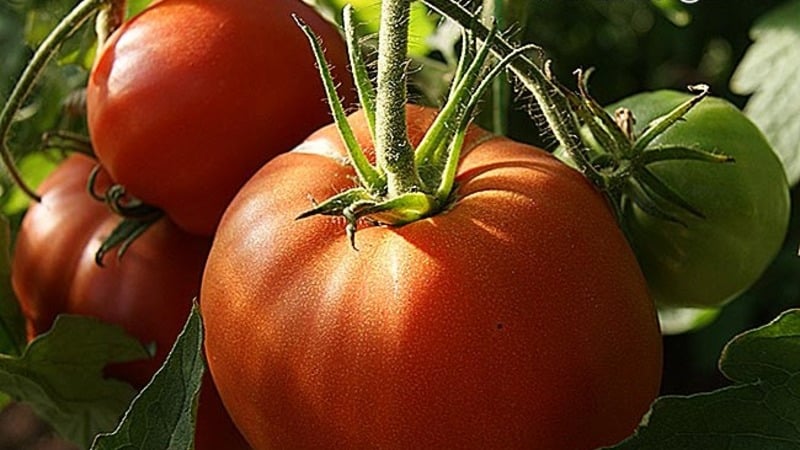
The culture is recommended for cultivation in open ground and in greenhouse conditions. Well adapted to drought.
The height of the bush is up to 1.5 m, the foliage is moderate, the leaves are large, dark green, and do not block the penetration of sunlight.
An early ripening variety, it takes 90–110 days from the first shoots to full ripening.
Productivity is high, from 1 sq. m, up to 20 kg of fruits are collected when placing 3-4 plants per 1 sq. m. m.
The need for garter is determined by the high growth and weight of the developing fruits, which can break loose branches. The crop also needs to be pruned regularly. Increased growth of side shoots will lead to dense plantings.
The culture is highly resistant to the main diseases of the nightshade family, such as: late blight and tobacco mosaic virus.
Fruit characteristics
The fruits are large, average weight 450–600 g, round in shape, deep red in color. The taste is sweet with a slight sourness, the flesh is juicy. There are 6–8 seed chambers, the number of seeds is average.
Ripe vegetables are used universally: they are equally suitable for fresh consumption and for winter preparations. Vegetables are also processed into tomato products for making juices, adjika, ketchup and lecho.
Ripe tomatoes have good keeping quality and can withstand transportation over any distance.
The photo shows Monomakh Cap tomatoes.
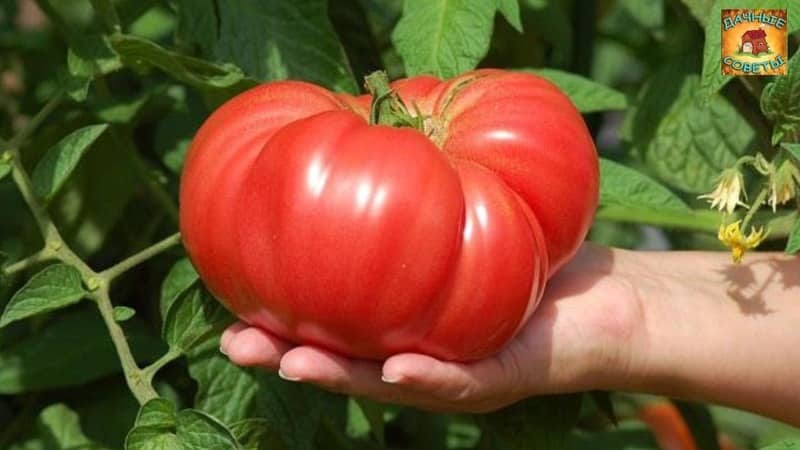
How to grow seedlings
Sowing of seeds begins 2 months before transplanting seedlings into the ground. Since the crop is varietal, seed material can be prepared independently. But such seeds require mandatory preparation.
Seed preparation
The seed material is laid out on the table and each seed is carefully inspected for visible damage. Then check for emptiness in the saline solution for 10 minutes. Grains suitable for planting should not float to the surface. Afterwards, the grains are disinfected in a weak solution of manganese for 25 minutes. Then they are thoroughly washed and dried.
Reference! A highly concentrated solution of manganese can ruin all seed material.
To improve germination, seeds are germinated on damp gauze for 2 days. Slightly moistened gauze is left in a dark place at a temperature of 27°C. As the gauze dries, sprinkle with warm, settled water.
Container and soil
The container is prepared in advance, treated for preventive purposes with a dark solution of potassium permanganate and small drainage holes are made at the bottom to drain excess moisture.
You can plant in a common wooden box and in separate plastic and peat cups.
Reference! When planting in peat containers, picking of plants is not required in the future.
The soil is prepared from garden soil mixed with peat in equal quantities. Washed river sand and a little wood ash are added to the resulting mixture for looseness. The soil is steamed in the oven for 10 minutes at a temperature of 50°C. In this way, the soil is disinfected. After disinfection, the soil is laid out in planting containers.
Sowing
Seeds are sown at a depth of 1.5–2 cm and at a distance of 3 cm from each other. Sprinkle peat on top, lightly moisten with warm, settled water and cover with film. The containers are left in a bright and warm room at a temperature of 24°C until germination.
Seedling care
When shoots appear, the film is removed and the containers are placed on the windowsill for better lighting. Daylight hours for seedlings should be at least 13 hours. If necessary, install fluorescent lamps.
Water the seedlings with moderately warm, settled water. After watering, the soil in the containers is loosened with a regular fork.
Reference! After loosening, the air permeability of the soil improves.
After the appearance of 3 true leaves, the seedlings are picked and placed in separate containers. When picking, only strong and healthy plants are left for further growth and development.
After picking, 10 days later the seedlings are fed with a complete complex fertilizer.
After 2 weeks before transplanting, the seedlings are hardened off in the open air during the daytime at a temperature of at least 16°C. Simultaneously with daytime hardening, the night temperature is reduced to 12°C.
How to grow tomatoes
From the photo and description it is clear that the Monomakh Cap tomato variety produces large and beautiful fruits. But to achieve such a result, you need to follow certain rules of care.
Landing
Planting pattern: 50 cm – distance between seedlings, 60 cm – distance between rows. For 1 sq. m place 3-4 plants. With a denser planting, the plants will interfere with each other’s full growth.
Before making beds, dolomite flour or wood ash is added to the soil. The tomato will not take root in acidic soil, so as a preventative measure, substances that reduce acidity are added.
The holes are made no deeper than 20 cm, a little wood ash is placed on the bottom and filled with warm water.
Transplant on a cloudy day or in the evening, deepening the seedlings to the first leaves. After transplanting, the holes are watered again and the young plants are left to get used to the new conditions for 1 week.
Subsequent tomato care
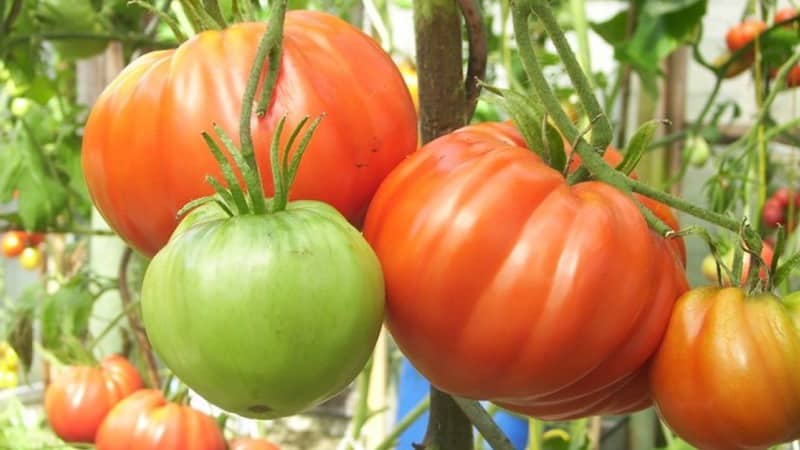
Proper care of the crop consists of regular moderate watering, weeding the beds and timely fertilizing.
Watered settled water without flooding the plants. With moderate watering, the humidity level does not exceed the norm, which prevents fungal spores from developing. After watering, the soil is loosened, thereby improving oxygen access to the roots. To keep the beds moist longer, they are mulched with straw. Mulching also prevents the penetration of ground insects.
The crop is fed at least 3 times per season. The first fertilizing is applied during flowering. Feed with a full range of fertilizers, mainly containing phosphorus. The second time is fed during the formation of ovaries. Add a full range of minerals or organic matter. From organic matter, bird droppings are used in a ratio of 1:15.
The third fertilizing is applied at the time of fruiting. Fertilize with a full complex with a predominant content of potassium substances.
Reference! The use of fresh manure and nitrogenous substances as fertilizers is not recommended. In this case, an increase in green mass is observed, and not the formation of ovaries.
Features of care and possible difficulties
The crop requires obligatory garter, since neither the stem nor the fruit-bearing branches can withstand the weight of ripe fruits. When transplanting, a wooden or metal support is installed next to each plant, to which the stem is immediately fixed. The fixed stem grows even and strong, without suffering from gusts of wind and precipitation.
As they grow, fruit-bearing branches are fixed to the support, since they are too heavy under the weight of ripe fruits.
The crop definitely needs pinching, and the procedure will have to be performed regularly, preventing unnecessary lateral processes from developing.
As the plant grows, it forms three stems, two of which are removed, leaving only one shoot under the first flower cluster. Thus, the bush is formed into 2 stems, one of which will be the main one. When growing in 2 stems, you can achieve not only maximum yield, but also the largest fruits.
Diseases and pests
The crop is considered resistant to major tomato diseases. Therefore, in the review we will focus on preventive measures.
When growing any agricultural crop, it is worth remembering the rules of crop rotation and not neglecting them. Following the recommendations guarantees maximum fruiting rates and protects plants from diseases and pests.
Tomatoes can only be planted on land where cabbage, carrots, legumes or winter crops previously grew.They do not deplete the soil, unlike the nightshade family, but, on the contrary, supply the soil with the nitrogen necessary for the development of the tomato.
With moderate watering, fungal spores will not be able to develop, which significantly reduces the risk of disease.
Loosening and hilling supply the roots with oxygen, which strengthens the plant's immunity, and mulching prevents the spread of ground pests.
Seedlings are also sprayed with fungicidal agents for preventive purposes.
To combat pests that are most dangerous to tomatoes, sharp-smelling herbs are planted next to the seedlings, the smell of which insects are afraid of. Basil, mustard and marigolds serve as good protection.
Nuances of breeding in open ground and in a greenhouse
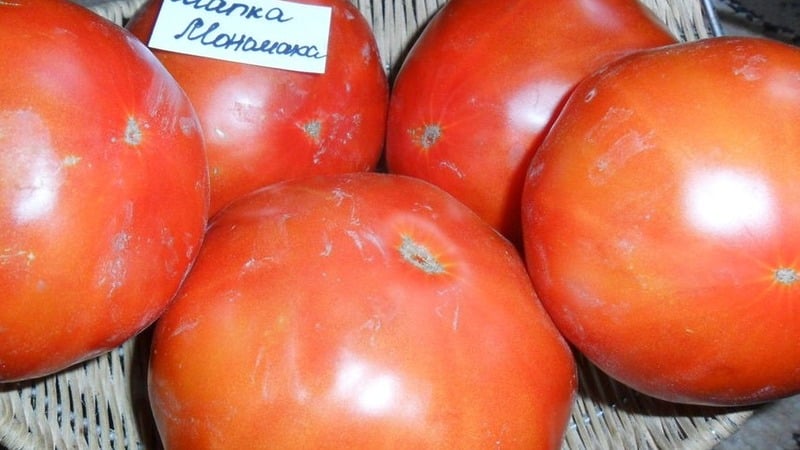
Although the crop is recommended for protected structures, when grown in greenhouses, the quantitative indicator is noticeably reduced, while the taste remains at the proper level.
When growing in greenhouses, it is important to prevent the plantings from becoming crowded by promptly removing excess side shoots and lower leaves. Frequent planting can provoke the development of fungal diseases. In addition, it is easy to miss many pests in them.
Closed structures must be ventilated every day, thereby preventing an increase in humidity and temperature. These factors increase the risk of attacks on seedlings by spider mites. Fresh air destroys the usual conditions for the existence of the parasite.
In order for the fruits to form larger, no more than 2–3 ovaries are left on the fruiting branch. In this case, nutrients will be spent only on their formation, due to which they gain more weight.
Harvesting and application
When harvested in a timely manner, ripe vegetables will delight you with their taste and appearance. In addition, an unloaded bush will speed up the ripening of other vegetables.
Due to the ideal combination of sugar and acids, the use of tomatoes is universal. They make excellent fresh dishes and winter preparations: marinades and pickles. But for whole-fruit canning, ripe vegetables are not suitable due to their large size.
Besides conservation, excellent juices, pastes, adjika, ketchups and sauces are obtained from tomatoes.
The durable peel allows you to store ripe vegetables for a long time and transport them over long distances.
Advantages and disadvantages
Judging by the characteristics and reviews with photos, the advantages of the variety are undeniable:
- drought resistance;
- takes root in all regions;
- unpretentious care;
- strong immunity;
- high yield;
- excellent taste;
- large fruits;
- universal application;
- long storage;
- long transportation;
- possibility of collecting seeds yourself.
The negative aspects include:
- regular stepsoning;
- plant formation;
- mandatory garter.
Farmer reviews
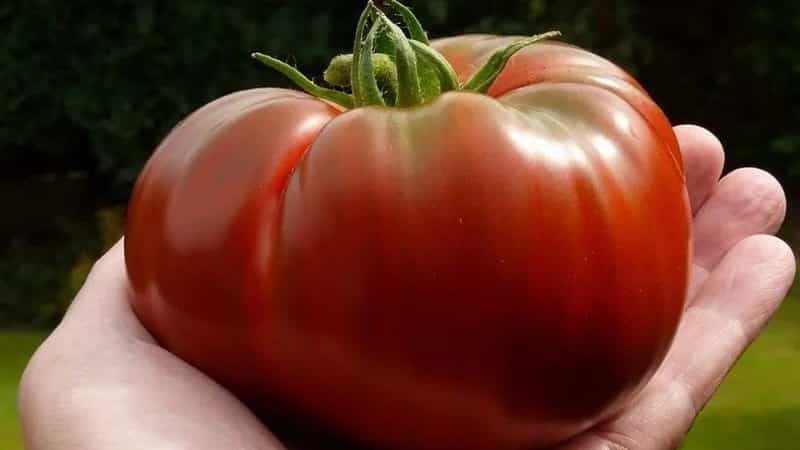
Reviews about the Monomakh's Cap tomato do not allow us to doubt the productivity of the crop, the quality of the fruits and easy care.
Tatyana, Vladimir region: “Large and sweet tomatoes are always on my table. I love this variety for its unpretentiousness and great yield. There are a lot of stepchildren, I don’t wait for them to outgrow, I remove them right away. I water and tie it up in a timely manner, but I get excellent results. I recommend this variety to all lovers of large tomatoes.”
Valery, Kaluga region: “I like the variety for its taste and the fact that it is excellent for processing. I love delicious juices and adjika.The juice from this tomato is not only tasty, but also very beautiful. Plants are disease resistant and undemanding to care. Another good thing is that you can collect the seeds yourself.”
Conclusion
The Monomakh Cap variety has remained a favorite among many gardeners for more than 15 years. This indicates the reliability of the crop, its resistance to various diseases, high fruiting rates and simple agricultural technology.
Ripe vegetables make not only excellent fresh dishes, but also winter preparations. Delicious fortified canned food is especially important in cold weather to maintain immunity and good mood.